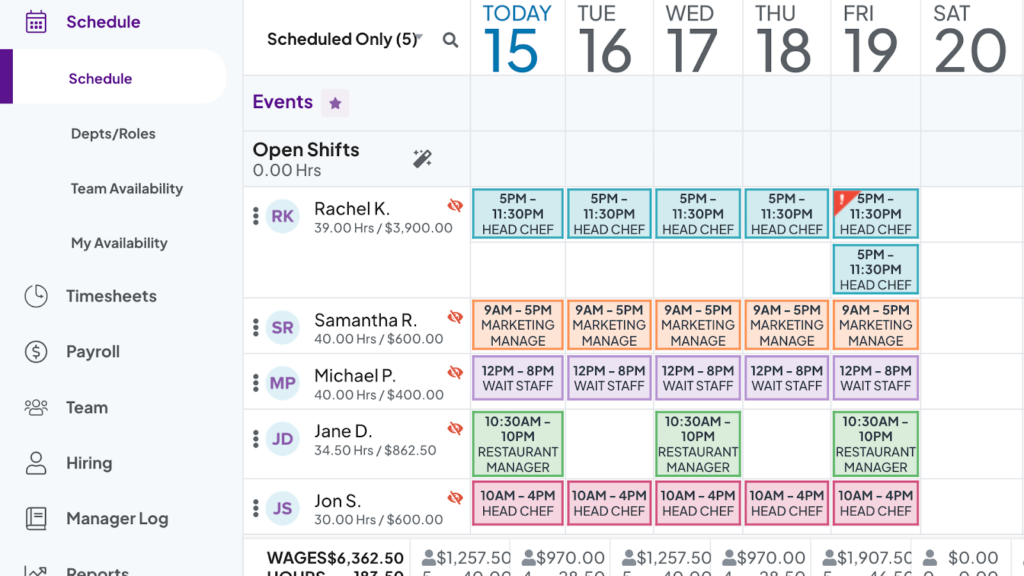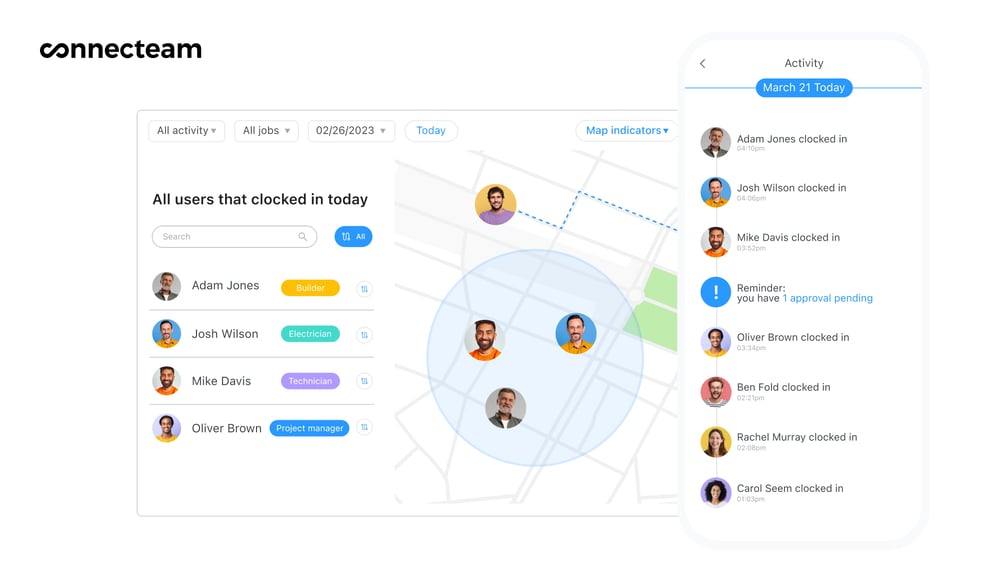Homebase brings HR extras and Sling keeps things budget‑friendly, but both come with trade‑offs that may leave some teams looking for a stronger alternative.
Caught between Homebase and Sling? Both platforms handle time tracking and scheduling, but they serve slightly different needs. Choosing the wrong tool could lead to overpaying for what you need, payroll mistakes, and frustrated staff.
In this guide, I break down exactly how each platform performs across the areas that matter most, so you can confidently choose the right tool for you.
A note about our method: All product comparisons and verdicts in this guide are based on hands-on testing by our expert team. All screenshots are original and were taken during actual tests.
At a Glance: Quick Summary
Homebase is best known for its all-in-one HR toolkit with built-in GPS time tracking, compliance alerts, and payroll integrations, making it ideal for businesses like cafés, retail shops, or service providers that need strong employee management features. That said, its per-location costs can add up.
Sling stands out with its simple, affordable scheduling platform and generous free plan, which is especially useful for small teams or businesses simply needing to create and manage shifts efficiently. Unfortunately, some useful features are locked behind high-cost plans.
Pricing and Plans
Before we get into numbers, here’s what you should know:
- Homebase charges per location. You pay a flat fee for each physical site you operate (a store, restaurant, office, etc.), regardless of how many employees work there. If you manage 3 cafés, for instance, you’ll need to pay separately for each one.
- Sling charges per user. You pay based on the number of active employees using the platform, regardless of where they work. If you have 20 staff across 5 locations, for example, you’ll be billed for 20 users.
Here’s how their pricing stacks up when comparing similar plan types:
| Plan Type | Homebase | Sling |
| Free | Basic 1 location and up to 10 users Includes basic scheduling and basic time tracking (point-of-sale integration and payroll add-on available) | Free Up to 30 users Includes shift scheduling, time off requests, available shifts, news sharing, long-term scheduling, and private messaging |
| Starter | Essentials $24/location/month Adds advanced scheduling, advanced time tracking, team communication, and payroll integrations | N/A |
| Premium / Pro | Plus $56/location/month Adds hiring tools, PTO and time off controls, and departments/permissions | Premium $1.70/user/month Adds mobile time tracking, labor cost management, overtime tracking, private and group messaging, and calendar synchronization |
| Business / Advanced | All-in-One $99.95/location/month Adds HR/compliance, onboarding, and labor cost controls | Business $3.40/user/month Adds kiosk time tracking, reports, no-shows, sick call-outs, and PTO management |
| * All prices show the monthly cost when billed annually as of July 2025. | ||
To me, Homebase works best if you run one or a few locations and want flat, predictable pricing with built-in HR tools.
In contrast, Sling is a strong choice if you have several workers across locations and need flexible per-user pricing that scales smoothly.
Pros and Cons
Homebase pros ✅
- Homebase combines scheduling, time tracking, hiring, and communication into a single interface, making it especially convenient for managers looking to consolidate their software.
- With features like labor cost controls and compliance support, Homebase works well for brick-and-mortar businesses with multiple users, including restaurants, retail, and other shift-based enterprises.
Homebase cons ❌
- Costs can rise quickly for growing businesses needing to add more locations or access features (like permissions and advanced tools) locked behind premium tiers.
- When we tested Homebase, our team noticed occasional app crashes and sync delays, which were frustrating.
Sling pros ✅
- Sling offers excellent scheduling tools for smaller teams, including support for open shifts, conflict alerts, and availability tracking.
- The free plan includes solid core features, such as team messaging and basic scheduling. I think it’s great for teams on a budget.
Sling cons ❌
- Time clocks, reports, and payroll exports are locked behind the priciest plan, which seems restrictive for budget-conscious teams.
- It lacks some HR and hiring tools, so if you need hiring, onboarding, or document storage, you’ll need to supplement with other tools.
Use Cases
Homebase is best for:
- Bringing everything into one place. If you want to handle scheduling, time tracking, payroll, and hiring without bouncing between tools, Homebase does a great job bundling it all together.
- Keeping labor costs under control. Homebase shows you how each schedule impacts your budget as you build it. That helps you catch overspending before it becomes a problem.
Sling is best for:
- Simple, reliable scheduling. During testing, our team found Sling super quick to set up. It’s ideal if all you need is a clean way to manage shifts and message your team.
- Working on a tight budget. The free plan covers up to 30 users, making it one of the most generous I’ve seen for small teams who still need proper scheduling tools.
Side-by-Side Feature Overview
Homebase and Sling offer essential time tracking and scheduling tools, but how they handle mobile access, paid time off (PTO), reporting, and compliance varies significantly.
Below, I compare them head-to-head across 8 different categories and declare a winner for each.
Time tracking – Winner: Homebase
Both Homebase and Sling deliver strong time tracking, but Homebase pulls ahead with its added flexibility and transparency.
Staff can clock in via mobile, desktop, shared kiosk, or even a point-of-sale (POS) terminal, and Homebase supports PIN-based logins on shared devices.
You can also block early clock-ins, enable auto clock-outs to prevent unplanned overtime, and set GPS or photo rules to confirm each clock-in. These guardrails, along with alerts for late clock-ins and overtime, help reduce errors and payroll creep.
Sling holds its own with robust essentials. You can use the mobile or desktop app, or set up a shared kiosk. Like Homebase, Sling supports geofencing, auto clock-outs before overtime accrues, and controls to prevent early clock-ins. All this helps keep payroll costs under control.
Where Sling falls a little short is usability on mobile: In our test, we couldn’t view the total hours worked by an employee without switching to desktop. That’s a small but meaningful limitation for managers on the go.

While both platforms provide smart tools for tracking time, Homebase edges out thanks to its broader device options, built-in GPS and photo verification, and slightly more polished mobile experience.
Employee scheduling – Winner: Homebase
I find Homebase’s scheduling features more powerful overall. You get a drag-and-drop scheduler with shift templates, availability tracking, open shift claiming, and automatic conflict detection.
As you add shifts, Homebase calculates projected labor costs (including overtime) and shows alerts if you’re getting close to your budget limits. This is super helpful for staying on track without needing a spreadsheet on the side.

Sling holds up well for everyday scheduling tasks. You get templates, recurring shifts, shift alarms, and the ability for staff to claim open shifts. It’s fast and intuitive, especially if you’re managing a single location. The downside is that Sling doesn’t offer built-in labor cost forecasting, which makes it harder to predict how your schedule will impact payroll.
Mobile app – Winner: Sling
Homebase offers a feature-rich mobile app that gives managers and employees extensive control. Staff can clock in and out, view schedules, request time off, and message teammates, all from their phones. Managers can edit shifts, approve requests, and receive real-time alerts, making it easy to handle last-minute changes without switching to desktop.
Sling’s mobile app includes all the essentials: scheduling, time tracking, time off requests, and group or individual messaging. It’s clean, intuitive, and generally more stable. Admin tasks like editing shifts and approvals are available, though they require more taps and feel less fluid compared with Homebase.
When we tested Sling, we found the layout user-friendly but a little more cramped than the desktop version. Both require an internet connection, so you can’t check for updates if you’re out of internet range.

However, app stability is a trade-off to consider.
Multiple Homebase users have reported occasional app crashes or sync delays, especially after updates. Sling isn’t as flexible, but its mobile experience tends to be more consistent, which can make a difference for teams who rely on their phones for everything, so long as they have internet access.
Overall, reliability and ease of use make Sling a better choice for people who value using the mobile app.
PTO and time off management – Winner: Homebase
Homebase makes managing paid time off feel seamless.
Employees can request leave from the mobile app, see their current PTO balances, and get notified when requests are approved or denied.
On the manager side, you can set custom PTO rules by role, seniority, or location. Once time off is approved, it syncs automatically with your scheduling calendar. You can also set up automatic PTO accruals, either fixed or hourly, so employee balances update in real time based on your custom policy. This kind of integration saves time and reduces scheduling conflicts.
Sling offers PTO requests on its Business plan, with manager approvals and real-time schedule updates. It lacks automatic accrual tracking or employee-visible balances, requiring manual oversight. In practice, this means that while Sling might help you collect time off requests, you’ll do administrative work to avoid overlaps and confusion.
In my eyes, Homebase delivers a much smoother PTO experience: It enables fewer manual steps and better visibility for staff and managers.
Reporting – Winner: Sling
Regarding reporting, Sling comes out on top, especially if you want flexibility in viewing and exporting your data.
I appreciated the range of reports Sling includes on its Business plan: labor cost breakdowns, payroll summaries, attendance trends, time off records, shift feedback, and sales comparisons. Reports are easy to generate and sort by role, group, or location, and you can export them as CSV, XLS, or print them as PDFs. You can also customize the date range to match your payroll cycle, which really streamlines the end-of-month workload.
Homebase covers many of the same categories (labor costs, shift feedback, and attendance), but we ran into limitations during testing. Some reports didn’t let us choose a custom time range, and exporting was available only for a few report types. You also can’t build your own reports or mix and match filters, which can be restrictive when trying to get specific answers.
Neither platform offers predictive analytics or AI-powered insights, so you mostly use raw data.
All in all, Sling wins here for giving you better control over the reporting experience and making it easier to align your data with how you run your business.
Integrations – Winner: Homebase
Homebase integrates with many popular platforms, including Square, Gusto, QuickBooks, Toast, Shopify, and ADP. These integrations become available starting from the Essentials plan and scale with higher-tier subscriptions.
For larger teams or custom workflows, API access is also included at upper pricing tiers, making connecting Homebase to other internal tools or third-party systems easy. This means less time spent manually transferring data and fewer errors across payroll, sales, and scheduling systems.
Sling offers limited integrations, including calendar syncs and payroll exports, with support for tools like Toast, Gusto, and QuickBooks.
In my eyes, Homebase is the clear winner for businesses that want a connected, automated ecosystem. Its out-of-the-box integrations reduce friction, save time, and support scalable operations without requiring additional tech workarounds.
Labor law compliance – Winner: Homebase
Both Homebase and Sling have tools to help you comply with labor laws, but Homebase goes a bit further in helping managers prevent issues before they arise.
With Homebase, you can configure alerts for missed breaks, overtime thresholds, and minor labor law violations. You can tailor rules by state or role, which is a big help if you manage employees in different jurisdictions.
One thing I find especially useful is how compliance settings are integrated directly into Homebase’s schedule builder. As you assign shifts, you’re warned if a schedule breaks any rules. That kind of visibility makes it easier to be proactive rather than reactive.
As for Sling, it offers some strong compliance tools, especially on the Business plan. It flags missed breaks and overtime, and I like that it can catch short shift turnarounds, such as in clopening shifts. These can be a real problem in industries like hospitality and states with strict rest time rules.
You can also set up alerts for events such as document expirations or certifications. The compliance features it does have are well-designed for smaller teams who still want to avoid missteps.
Ultimately, I think Homebase wins for compliance depth and proactive scheduling safeguards. Even so, Sling does more than you might expect, especially for a tool that keeps things lean and affordable.
Messaging – Winner: Sling
Both Homebase and Sling let you message team members directly, send group announcements, and comment on shifts. But to me, Sling’s messaging feels more reliable and flexible.
I like that Sling includes messaging even on the free plan. That meant we could test everything without upgrading, and it worked smoothly straight out of the box. I also appreciate being able to filter messages by team, role, or location; this is excellent for keeping communication focused.
With Homebase, messaging is available only on the Essentials plan or higher. The messaging tool interface is clean, and I like how conversations tie into the schedule. But when we tried using it on mobile, our tester ran into occasional lags and slow notifications—something we noticed other users reported.
User Ratings
Both apps are highly rated on user review sites and have very similar average scores.
Homebase
Sling
Security & Compliance
Here’s how Homebase and Sling stack up when it comes to data protection and admin controls:
| Category | Homebase | Sling |
| Data Encryption | ✅ AES-256 (in transit and at rest) | ✅ AES-256 (in transit and at rest) |
| GDPR Compliant | ✅ | ✅ |
| Hosting Region | US (Amazon AWS) | US (Amazon AWS) |
| Admin Controls | ✅ Role-based permissions, audit logging available | ✅ Role-based permissions, audit logging available |
| Data Retention Policies | ✅ Configurable retention periods, compliance with legal requirements | ✅ Configurable retention periods, compliance with applicable regulations |
| Two-Factor Authentication | ✅ (optional MFA via email, SMS, or authenticator apps) | ✅ (via Google Authenticator, SMS, or email) |
| Certifications | ✅SOC 2 Type II, GDPR compliance(HIPAA not specified) | ✅ SOC 2 Type II, GDPR compliance(HIPAA not specified) |
From what I’ve seen, both Homebase and Sling cover the security basics well. They use AES-256 encryption, comply with the General Data Protection Regulation (GDPR), and host data on Amazon Web Services (AWS) in the US.
They also offer solid admin controls like role-based access and audit logs, and let you configure data retention based on your needs. Two-factor authentication is available on each: Sling supports Google Authenticator, while Homebase gives you a few options, including SMS and email.
They’re also both SOC 2-certified, which gives me confidence in their data handling.
However, neither mentions compliance with the Health Insurance Portability and Accountability Act (HIPAA), so keep this in mind if your industry requires it.
Setup and Onboarding
Homebase is built for fast, self-guided setup. Most businesses can complete onboarding in just a few hours. The platform provides guided flows, schedule templates, and a user-friendly interface that helps new users get comfortable quickly. There’s also a detailed help center with videos and written tutorials, along with email support for setup-related questions.
Sling offers a similarly straightforward setup process. Users can typically configure the system and start building schedules within the same day. It includes quick-start guides and a simple interface, but the onboarding support is more limited. Users must rely on written documentation and email support, as Sling doesn’t provide live or personalized onboarding assistance.
Support and Customer Service
Good support can make a big difference when software issues arise. Here’s how Homebase and Sling compare when it comes to helping users get answers and resolve problems.
| Support Type | Homebase | Sling |
| 24/7 Chat | ❌ | ❌ |
| Phone Support | ✅ (paid plans) | ✅ |
| Email Support | ✅ | ✅ |
| Help Center | ✅ | ✅ |
Both Homebase and Sling provide searchable help centers with tutorials and walkthroughs for common tasks. Homebase also allows paid users to contact support via phone for more complex issues, while Sling relies entirely on written resources and email communication.
Neither offers 24/7 live chat support. On paid plans, Homebase offers chat support from 8:00 a.m. to 7:00 p.m. CST, Monday–Friday (excluding holidays). Sling offers chat support from 8:00 a.m. to 8:00 p.m. ET, Monday–Friday, and 10:00 a.m. to 6:30 p.m. ET on weekends.

🏆 Who Wins: Homebase or Sling?
For businesses choosing between these 2 platforms, the decision often comes down to the depth of features versus simplicity and cost.
| Choose Homebase if you… | Choose Sling if you… |
| Need advanced time tracking, scheduling, payroll, hiring, and labor law compliance in one place. | Want a simple, low-cost way to manage schedules and communicate with employees. |
| Manage hourly or shift-based teams that need GPS, PTO tracking, and labor cost controls. | Need a flexible solution for remote or multi-location teams, with strong shift swapping and messaging. |
| Read our in-depth Homebase review | Read our in-depth Sling review |
Our take
If you need an all-in-one toolkit with comprehensive features, Homebase is the better fit.
But if you’re looking for a basic and affordable solution focused on scheduling and messaging, Sling may be more your style.
Connecteam vs. Homebase vs. Sling
Homebase and Sling offer essentials like time tracking, scheduling, team messaging, geofencing, and compliance. But Connecteam brings more depth across nearly every area.
For starters, Connecteam’s real-time GPS tracker shows team members’ locations in real-time, not just at clock-in, and enables you to manage multiple job sites easily.

You also get custom digital forms and checklists. These are missing from both Homebase and Sling.
While Homebase handles payroll and hiring, Connecteam focuses on operations and internal coordination, making it a stronger fit for field service, construction, logistics, hospitality, and any team that works off-site. Everything is mobile-first and modular with Connecteam, so you can add tools as you grow.
Support with Connecteam is consistent and reliable, too. Unlike Sling and Homebase, Connecteam includes 24/7 live chat and email support on all plans.
Here’s how the 3 platforms stack up side by side:
| Feature | Connecteam | Homebase | Sling |
| Time Tracking | ✅ Mobile, kiosk, GPS, geofencing, logs | ✅ Mobile, kiosk, and GPS capture | ✅ Mobile, kiosk |
| Scheduling | ✅ Drag-and-drop, templates, auto-scheduling | ✅ Drag-and-drop, templates, auto-scheduling | ✅ Drag-and-drop, templates, auto-scheduling |
| Time off requests and accrual tracking | ✅ | ✅ | ❌ Time off requests only |
| Break enforcement | ✅ | ❌ Break alerts only | ❌ Break alerts only |
| Custom forms | ✅ | ❌ | ❌ |
| Full-featured mobile app | ✅ | ✅ | ❌ Moderate (basic scheduling, tracking, less intuitive) |
| Integrations | Gusto Quickbooks Xero Paychex ADP Zapier Wix Bookings Lightspeed PrismHR | Payroll, POS, job boards (27+ systems) | Limited (Gusto, QuickBooks, Shopify, Toast) |
| Free Plan | ✅ Up to 10 users | ✅ Up to 10 users, one location | ✅ Up to 30 users |
| 24/7 support | ✅ | ❌ | ❌ |
Overall, if you’re after a comprehensive, all-in-one platform that goes beyond just tracking time or building schedules, Connecteam is the obvious choice!
Try Connecteam for free today.
FAQs
What is the difference between Sling and Homebase?
Homebase is a more complete workforce management tool with built-in scheduling, time tracking, payroll, hiring, and labor compliance. Sling is designed for simpler needs (mainly scheduling and messaging), making it a better fit for smaller teams or those managing multiple locations on a budget.
Is Sling a good scheduling app?
Yes. Sling lets you build and share schedules, track availability, and manage shift swaps. It also includes other features, like geofencing, break alerts, and overtime warnings.
Is Homebase good for scheduling?
Yes. Homebase offers drag-and-drop scheduling, shift templates, time off and availability tracking, and labor cost forecasting built right into the calendar.
Who owns Sling scheduling?
Sling is owned by Toast, Inc., a major software company in the hospitality space. Toast acquired Sling in 2021 to help restaurants and shift-based teams manage scheduling and communication more efficiently. Sling still works as a standalone app and continues to serve a wide range of industries beyond food service.

